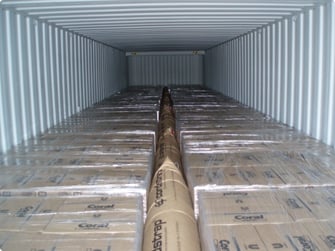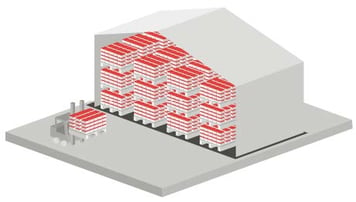Remember the movie Cast Away? It’s the one in which Tom Hanks is a FedEx executive who survives a plane crash and ends up stranded on a deserted island. You may not remember the movie’s opening minutes. Hanks’s character is on the job in an international FedEx facility during the busy holiday shipping rush. He and his fellow FedEx employees are obsessed with every possible second they can cut from the delivery timeline.
Hanks’s obsession over lost seconds isn’t fantasy. It’s everyday reality for FedEx. The shipping company knows that a lost second or minute isn’t an isolated incident. That lost time, compounded over each package and each step in the delivery process, can aggregate to a substantial amount of waste every year.
One of your biggest time wasters may be the time spent unpacking vendor containers.
The same is true of lost time in your facility. Scale those lost minutes across all of your team members over an entire year, and you could have a serious problem on your hands. One of your biggest time wasters may be the time spent unpacking vendor containers.
Your suppliers have the best intentions when it comes to ensuring quality. That’s why they ship their parts and materials in large containers packed full of dunnage. The problem is that your employees are the ones who have to deal with that dunnage and packaging.
The time they spend sifting through dunnage and packaging could be better spent on their primary tasks. You don’t want your skilled machinists, engineers, and other team members spending time taking foam peanuts, cardboard, or compressed airbags to the dumpster.
You want your vendors to package your parts and materials in a way that protects quality. However, you also want them to package in a way that protects your team’s time and your bottom line. How do you accomplish those competing objectives?
The Custom Engineered Packaging Solution
One strategy is to implement a custom-engineered solution across your supply chain, or at least with your most high-volume suppliers. In a custom engineered solution, you work with a third-party packaging company to analyze your entire supply chain and your packaging needs.
The packaging partner assesses quality risks, protection needs, and how packaging and dunnage impact your time, resources, and bottom line. The packaging company then develops a custom solution to minimize risks, ensure quality, and protect your facility’s resources.
One strategy is to implement a custom-engineered solution across your supply chain, or at least with your most high-volume suppliers.
As you might imagine, every custom-engineered solution is different because every company’s needs are different. However, there are a few elements that are often used in such solutions. For example, a custom-engineered supply chain packaging solution may include:
— Rotables
You have a high-volume supplier who sends you the same shipment of parts on a regular basis. And with every shipment, your team is left with a pile of packaging materials and dunnage to eliminate. Why? What’s the purpose of using new packaging for every shipment if the parts and materials are essentially the same?
 A solution that includes rotable packaging could help you reduce costs. A packaging partner can produce rotable packaging that is durable and custom designed for your needs. Your team receives the shipment, removes the product, and then sends the packaging back to the supplier. They then reuse the packaging for the next shipment.
A solution that includes rotable packaging could help you reduce costs. A packaging partner can produce rotable packaging that is durable and custom designed for your needs. Your team receives the shipment, removes the product, and then sends the packaging back to the supplier. They then reuse the packaging for the next shipment.
You eliminate any need for waste removal with regard to the packaging. There is no packaging waste. Similarly, your supplier doesn’t have to produce new packaging for each shipment. That should translate into cost savings for you.
— Redesigned Dunnage
Dunnage plays an important role in protecting quality. However, it can also consume your time and cost you money. Your workers have to remove the dunnage from each shipment and then remove it from your facility.
 The truth is that there are likely alternative ways to ensure product quality without stuffing the crate full of cardboard, shredded paper, or foam peanuts. Instead, quality protection should start with package design.
The truth is that there are likely alternative ways to ensure product quality without stuffing the crate full of cardboard, shredded paper, or foam peanuts. Instead, quality protection should start with package design.
As part of a custom-engineered solution, your packaging partner should redesign the packaging in a way that minimizes risk without the need for excessive dunnage. Obviously, those solutions differ based on the needs and objectives of the company involved. However, experienced packaging companies should have engineers on staff who can create a design that minimizes both quality threats and dunnage.
— Packaging Hub
One challenge in a custom-engineered supply chain solution is that you may not be able to implement your new packaging strategy with every vendor you have. High volume suppliers with whom you have a strong relationship may be able to revamp their packaging based on your custom solution. However, if you have a many different suppliers, some of them may not have the resources to implement new packaging.
An alternative is to open a packaging hub. Your suppliers ship their products and materials directly to the hub, using only the minimum amount of packaging and dunnage necessary to protect quality for that leg of the trip.
 Once in the hub, your packaging partner unpacks the containers and repacks them to meet your quality standards and to reduce wasteful materials and dunnage. The packaging partner can also bundle parts and materials from different vendors together, streamlining the receiving process in your facility.
Once in the hub, your packaging partner unpacks the containers and repacks them to meet your quality standards and to reduce wasteful materials and dunnage. The packaging partner can also bundle parts and materials from different vendors together, streamlining the receiving process in your facility.
An ancillary, but important, benefit of a hub is that you may get more transparency into your supply chain. The hub team can use barcodes and scanners to check in packages and track them through the process. That information can integrate with your system so you can always see where your parts and materials are located.
If you’re looking for ways to cut costs and operate at greater efficiency, look at the packaging that arrives from your suppliers on a daily basis. How much time and money is being used to breakdown and eliminate that packaging? If your company is like many other manufacturing and industrial businesses, the answer is too much.
A custom engineered packaging solution may be the right strategy for your supply chain. Analyze your suppliers’ packaging, your efficiency and productivity, and talk to several packaging engineering companies to discuss your options which might reduce labor costs. ![]()







Let Us Know What You Thought about this Post.
Put your Comment Below.